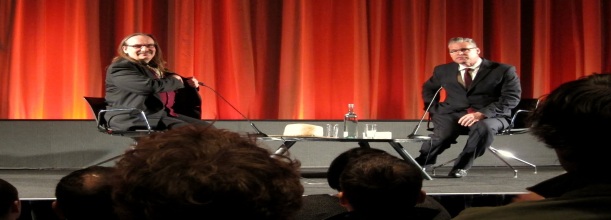Kim Newman and Mark Kermode in conversation at the BFI

In celebration of Kim Newman’s updated edition of terror tome Nightmare Movies, the author and his fellow genre-savant Mark Kermode took to Southbank’s BFI stage last week to discuss “all things horror”, followed by a retro screening of John D. Hancock’s psycho-thriller classic, Let’s Scare Jessica To Death.
Navigated by the reigning overlords of horror critique, the night explored a multitude of bloody avenues and freakish angles, from the Eli Roths and Rob Zombies of the new directorial generation, whose ‘privileged backgrounds’ are effectively informing a very disturbing, if not ill-advised, set of genre narratives, to the lost art of surreal storytelling and a saturated film market run amok with Japanese ghost girls. Surprisingly, amidst lavish derision for some big-named filmmakers and films (not even James Wan’s acclaimed hit Insidious was spared) the nexus of Newman and Kermode’s dialogue was the idea of subjective enjoyment and the uncanny ability of nostalgia to wear away at critical first impressions. Newman subtly tackles this concept in his latest edition of Nightmare Movies, but the highly personal, enigmatic allure of horror films was boldly amplified in his film choice for the evening – Let’s Scare Jessica To Death, a 70s mash-up of hippie vampires, geriatric zombies, indulgent paranoia and American Gothic overtones.
The story follows the eponymous Jessica (Zohra Lampert), a paranoiac fresh from a stint in a psychiatric hospital, who moves to a Victorian farmhouse in rural nowhereland with her husband (Barton Heyman), and a friend (Kevin O’ Connor). Once there, the trio encounters a seemingly transient hippie named Emily (Mariclare Costello) who has been living in the old house and surviving on undisclosed resources. The two men are drawn to the unexpected houseguest, but Jessica begins to hear sinister voices and see frightening things, with Emily as the apparent catalyst. Tortured as much by the uncertainty of her fragile sanity as by her husband and friend’s incredulous disbelief in her claims, Jessica distances herself and draws further into her fractured psyche. In a climactic fit of hysteria, Jessica sees resident flower-child Emily revealed to be an antiquated vampire bride (and the all-male townsfolk are in fact her zombified, fang-bangin’ minions). By then, however, Jessica is already alone in her struggle against Emily’s malevolent advances and her approaching psychosis, and as she attempts to escape the clutches of the dress-clad evil, the chasm between what is real and what is imagined only grows wider.

Lampert plunges into the inevitable lunacy with an arresting sincerity, and the smorgasbord of genre archetypes represent the literal horror story that is her character’s inner world. The open-endedness of the narrative is potentially clever; what seem like plot holes could very well be opportunities for individual interpretation, and if anything, the plaguing preternatural occurrences (that at times appear untethered to the actual storyline) exploit the unreasonable tendency of the viewer to demand logical explanations for a paranoid-style scenario to which logic cannot be applied.

Let’s Scare Jessica To Death is a disconcerting story, largely due to irrelevances, loose ends and ambiguities. And yet the characteristic 70s gritty aesthetic and bizarre score is probably more disturbing (and show-stealing) than the trope-heavy plot itself. Viewed outside of its decade, the nascent visual, auditory and conceptual storytelling techniques (fish-eye close-ups, a jolting, tinny soundtrack and drawn-out scenes, etc.) that would go on to be refined and celebrated in later films appear clumsily experimental and are easily unappreciated, and the socio-political subtext of distrust for the free love/ free spirit ideology post-Manson Family is near-irrelevant.
Ultimately – and befittingly – Newman’s enthusiasm for the rough-hewn, hippie ghost story (that he also introduced as being “scarier than Halloween”) brought the evening’s pivotal theme about personal enjoyment and the power of nostalgia to a sharply defined point, with the film’s appeal best being described thus: You obviously had to be there – in 1971, that is.





Recent Comments